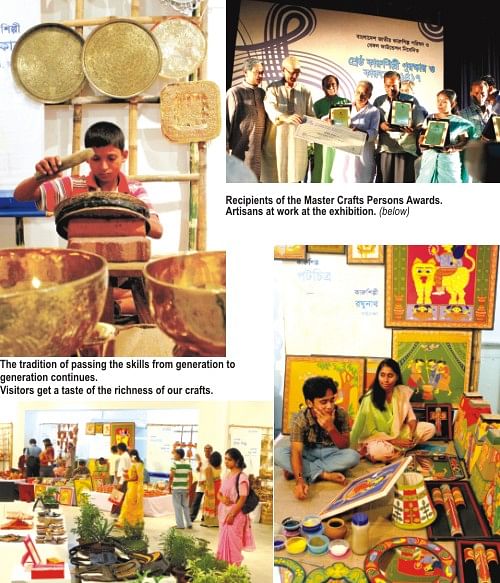| Achievement
Reviving
Fading
Traditions
Anika Hossain
Kamal Chandra Sarkar has been fascinated by instrumental music for sixty four years. He is not only an accomplished flautist, but has dedicated his life to creating the instruments that have given him much joy and delight and provided an income for his large family of four children. The instrument he creates is a simple one, a long hollow bamboo pole with some holes cut into it, but the melody it can produce, when handled by a proficient is nothing short of heavenly. Sarkar's only regret is that this tradition of flute making, which has been passed on in his family for generations, will not continue after him. His children showed no interest in learning this skill and are hoping to engage in a more profitable trade.
Crafts and textile have been a part of Bangladeshi culture and heritage for centuries. Every country with a rich cultural background is proud to display the handiwork of its artisans, to promote trade and tourism. The work of Bangladeshi artisans reflects thousands of years of history, folk lore, literature and music. The country's landscapes, climate, mixture of ethnicities and its customs are also incorporated into its artistry.
However, the industrial advancement and modernisation of the country now provides more opportunities for its people and many traditional craftsmen prefer to educate their children in hope that they will have a better life than their fore fathers. As a result, the age long tradition of passing on skills from generation to generation is slowly fading.
To keep this tradition alive, to appreciate our artisans and encourage their future generations to remain in the trade, the National Crafts Council of Bangladesh (NCCB) introduced the Master-crafts-persons Award. This award was first initiated in 1989, shortly after the liberation war. 47 artisans specialising in 26 different categories of craftsmanship have received this award so far.

This year, NCCB joined by the Bengal Foundation have organised the Master-crafts-persons Award ceremony, followed by a five day long crafts fair, which has started on the September 18 and scheduled to wrap up on the 22, at the Nalinikanta Bhattashali Hall of the National Museum. This year, the award was given to four categories- the leather industry, stitch industry and shade work, the tapestry and instrument-flute industry.
The winner from the instrument-flute industry was of course, Kamal Chandra Sarkar from Jhenidah. Shilpi Rani Biswas, from Narayanganj took away the award for the best stitch work. “It took me twenty days to make this design,” says Shilpa Rani, as she shows her handiwork to an admiring audience. “I would like to thank my creator for giving me my talent and my loved ones for shaping it for me. I would not be here without them. I am very proud of myself today,” she says, wiping away her tears of happiness.
Ratan Chandra Das, from Rayer Bazaar won the award for the best talent in the leather industry. Das learned his skills from his father. The production of leather foot wear has been a family business for them for many years. Das's father was his friend, his guide and his mentor. When he was in class nine grade, due to financial and family problems, he dropped out of school and had to join the leather industry. Although he regrets not completing his education, he takes pride in the fact that he was able to pass on his skills, not only to his sons, but many others as well. At 54, Ratan Chandra Das has finally received recognition for his extraordinary talent, and hopes his offspring will carry on the family tradition.
From the tapestry industry category, the winner was Kartik Bashak from Tangail. At 65, Kartik Bashak has been creating stunning designs for saris and tapestry for the past 42 years. He has been working tirelessly to create original patterns and styles by combining designs from the olden days with more modern patterns. His two sons also possess his talent for tapestry work and were present at the award ceremony to watch their father being honoured for his lifetime achievements. Bashak hopes that his sons will also put in the same energy and dedication into their work and win an award someday.
The Nalinikanta Bhattashali Hall was teeming with people soon after the award ceremony. 25 stalls, laid out inside the brightly lit hall, are laden with magnificent, original handmade crafts. The artisans were hard at work, with their looms, carving tools, paint and polish. There were stalls for intricately carved brass ornaments, silver jewellery, colourful masks, clay sculptures and pottery, jute work, bamboo art, flutes, matts made from thin strips of wood ( pati) hand stitched blankets, hand fans made of thread, bamboo and wood, leather goods and musical instruments (ektara, do-tara). In the centre of the hall, the award winning crafts have been displayed. The sight was spectacular to behold.
The large crowd that this event has attracted so far is extremely encouraging and shows the willingness of the Bangladeshi citizens to revive their cultural heritage. One hopes that people will continue to attend and organise many similar events in the future and will take pride in their rich traditional background and the legacy left behind by their ancestors.
Copyright
(R) thedailystar.net 2010 |
|
